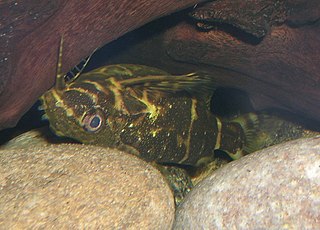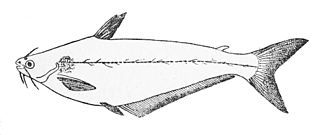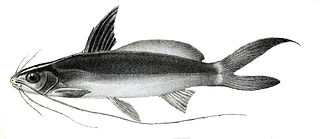
Mackerel is a common name applied to a number of different species of pelagic fish, mostly from the family Scombridae. They are found in both temperate and tropical seas, mostly living along the coast or offshore in the oceanic environment.

The International Union for Conservation of Nature (IUCN) Red List of Threatened Species, founded in 1964, is the world's most comprehensive inventory of the global conservation status of biological species. It uses a set of precise criteria to evaluate the extinction risk of thousands of species and subspecies. These criteria are relevant to all species and all regions of the world. With its strong scientific base, the IUCN Red List is recognized as the most authoritative guide to the status of biological diversity. A series of Regional Red Lists are produced by countries or organizations, which assess the risk of extinction to species within a political management unit.

A species that is extinct in the wild (EW) is one that has been categorized by the International Union for Conservation of Nature as known only by living members kept in captivity or as a naturalized population outside its historic range due to massive habitat loss.
This article is a list of biological species, subspecies, and evolutionary significant units that are known to have become extinct during the Holocene, the current geologic epoch, ordered by their known or approximate date of disappearance from oldest to most recent.

The name upside-down catfish is most commonly used by aquarists to refer to the mochokid catfish Synodontis nigriventris alternately known to ichthyologists as the blotched upside-down catfish or false upside-down catfish. However, a number of other fish may also be known by this name:

Mystus is a genus of fish in the family Bagridae native to Asia. Phylogenetic relationships within this genus are poorly understood, though it has been suggested that there are two major lineages.

The African butter catfish is a species of fish in the family Schilbeidae. It is native to many major river systems in Africa. Other common names for the fish include butter fish, butter barbel, African glass catfish, lubangu, mystus catfish, silver barbel, and silver catfish. It was originally described as Silurus mystus by Carl Linnaeus in 1758.
Hemibagrus punctatus is a fish species first described by Jerdon in 1849. Hemibagrus punctatus is a member of the genus Hemibagrus and the family Bagridae. It is endemic to east-flowing rivers in the Western Ghats of India. Of these, the species is likely only found in the Kaveri River; records from the Krishna River may actually be of H. maydelli. However, one record from the west-flowing Bharatappuzha River has been tentatively assigned to this species. The last record of this species was in 1998, and it may have experienced a population decline of nearly 100%; thus, IUCN categorizes the species as critically endangered. It is threatened by habitat degradation by excess siltation, excess fishing, and dam construction. However, based on several specimens caught by fishermen between 2011-2012 that likely belong to this species, as well as testimonies from local fishers, moderate populations of this species may still be extant in the region.

Mystus cavasius, the Gangetic mystus, is a species of catfish of the family Bagridae.

Mystus gulio, the Long Whiskers Catfish, is a species of catfish of the family Bagridae. The generic name is probably derived from the Latin "mystax", meaning "moustache", due to the long barbels.

Mystus vittatus, the striped dwarf catfish, is a species of catfish of the family Bagridae. It is found in brackish water systems with marginal vegetation in lakes and swamps with a mud substrate of Asian countries Pakistan, India, Sri Lanka, Nepal, Bangladesh and probably Myanmar. Populations of Southeast Asian countries is in debate, due to close morphological similarities among Mystus species in that region.

Clarias brachysoma is a species of fish in the family Clariidae. It is endemic to Sri Lanka. Its natural habitats are rain forest streams and lowland rivers. It is threatened by habitat loss.
Mystus ankutta, also known as the Sri Lanka dwarf catfish or yellow dwarf catfish, is a species of catfish of the family Bagridae that is endemic to Sri Lanka. In the wild it is found in freshwater bodies from Kelani river to Nilwala river in Sri Lanka.
Mystus falcarius is a species of catfish endemic to India and Myanmar and is known only from Irrawaddy River, Great Tenasserim River and Chindwin River. The exact population is not known but is thought to be abundant and no exact threats are known thus Least Concern by the IUCN; it is fished for food.
Mystus bocourti is a species of catfish endemic to Cambodia, Laos, Thailand and Vietnam, known only from Chao Phraya River and Mekong River. It was formerly listed as Heterobagrus bocourti until the genus Heterobagrus became Mystus. It is demersal and potamodromus and occurs in medium to large rivers. The fish considered rare and declining throughout its range and is threatened by pollution, present and future dams and water extraction for agriculture and human settlements. Considering this and no present conservation measures, the fish is listed as Vulnerable.
Mystus albolineatus is a species of catfish endemic to Cambodia, Thailand and Vietnam, known from Chao Phraya River, Bang Pakong River, Mekong River and Tonlé Sap. It is found in flowing and standing waters especially near submerged woody vegetation; it feeds on zooplankton, fishes and insect larvae such as chironomidae. It spawns before or during the rainy season and the young were first caught in July and August. It occurs in both the market and aquarium trade and is fished with seines, gillnets and traps. It is not considered threatened thus listed Least Concern, however, further research about this fish is needed.
Mystus atrifasciatus is a species of catfish endemic to Cambodia, Laos, Thailand and Vietnam, known from Mekong River, Chao Phraya River and Mae Klong River and was described from Phitsanulok, Thailand. It inhabits rivers, streams and reservoirs and moves to floodplains when the water level increases and can also be found near submerged woody vegetation. It feeds on crustaceans and zooplankton along with some algae and fish scales. It is commonly fished and marketed and is also found in the aquarium trade. It may be threatened by pollution and overfishing and more research is needed about the species.

Hail Haor Wildlife Sanctuary is a major wildlife sanctuary in Bangladesh. It is one of the most important wetlands in the Sylhet Basin for the resident and migratory waterfowls. It is also important watersource for the inhabitants living around when all other sources dry up during summer. The sanctuary is located in Moulvibazar District, in the northeast region of the country.











